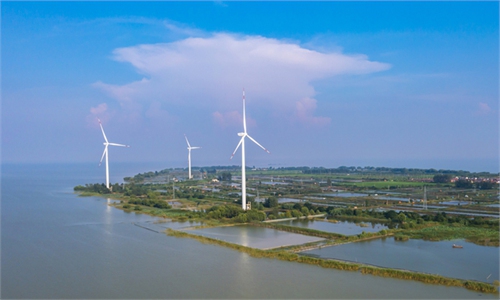China to create first green stock index in fresh push to curb carbon emission
New guideline expands financial tools to support carbon neutrality goal

A staffer works in a photovoltaic company in Haian, East China's Jiangsu Province on Sunday. Chinese photovoltaic companies are embracing the carbon neutrality goal in China, which is conducive to enhancing the upgrading and transformation of the manufacturing industry. Photo: cnsphoto
China will set up a green stock index and develop futures trading for carbon emission rights - both of which will be the first such instruments, according to a new sweeping guideline issued on Sunday, marking an important step in expanding China's market-oriented securitization and financing mechanisms to accelerate the country's long-term carbon trading and achieve its carbon neutrality goal.
China will also research and develop financing tools based on multiple environmental resources rights, including pollution emission rights, water rights and carbon emission rights, according to the guideline jointly issued by the General Office of the Communist Party of China Central Committee and the General Office of the State Council, China's cabinet. The guideline aims to deepen reforms on environmental protection compensation mechanism.
The measures are explorations in fostering energy conservation and environmental protection goals with securitization tools, with the key goal focusing on reducing carbon emissions in the country, Yang Fuqiang, a research fellow at Peking University's Research Institute for Energy, told the Global Times on Sunday.
Prior to the announcement, China had yet to launch a green stock index. In August 2020, global stock markets index provider MSCI unveiled two climate change indexes for China to gauge the country's transition to a low-carbon economy.
The official set-up of the stock index allows investors to measure listed companies' environmental, social and governance (ESG) stewardship, which will serve as a reminder for companies to make plans for green investment and constrain their carbon emissions, industry observers said. It will also affect companies' re-financing and convertible bond issuance.
China's national carbon market, the largest emissions trading system (ETS) in the world, was officially launched in July. The futures trading market would be a supplement to the national carbon market, signaling the complete securitization of carbon trading.
According to the guideline, projects involving voluntary reductions of greenhouse gas emissions such as renewable energy resources and methane utilization will also be included in the national carbon emission trading market.
China's carbon market is the world's largest, with emissions of 6 billion tons, compared with the EU's 3 billion tons. China's pledge to be carbon neutral by 2060 would entail investments totaling 136 trillion yuan ($21.07 trillion), according to industry estimates revealed during the China International Fair for Trade in Services last week.
Dong Shaopeng, a senior research fellow of the Chongyang Institute for Financial Studies at Renmin University of China, told the Global Times on Sunday that new instruments, such as the green stock index, are meant to provide a reference for investors increasingly interested in in green industries.
The green index features qualified companies and bars underqualified companies from access to more fund from investors, Dong said.
The move would be yet another effort to expand financial tools, including equities, refinancing and bonds, to foster green investment.
"A green stock index can be regarded as the answer from the China Securities Regulatory Commission to green bonds from China's central bank and both are tools to foster green development," Dong noted.
In terms of financing tools for water, Yang said the efforts could push up the prices of water with the help of market tools, which will help foster water conservation and protection.
China's average per capita water resources stand at only half of the world's average, and a market tool governing the water consumption would be particularly useful for areas along the Yellow River, where provinces struggle for water for agricultural and industrial use, while provinces located upstream have an advantage, according to analysts.
The guideline noted that China will expand the scope of green finance reform and innovation pilot areas. It encourages banks and financial institutions to provide green credit service to green financing projects, eligible non-financial enterprises and organizations to issue green bonds, and insurance institutions to develop innovative green insurance products to participate in environmental protection compensation.
China will put its carbon emissions peak and carbon neutrality goals into the country's medium- and long-term development plans to further fulfill the promises made to strengthen global climate cooperation, China's top climate envoy Xie Zhenhua said during the Beautiful China Forum 100 held in Beijing on Saturday.
Xie noted that a special working group has been established, and it is establishing a policy system targeting carbon emission reductions.
The system will first coordinate carbon emission reductions with security issues in multiple sectors in energy, food, industry and the supply chain, and designate peak carbon emissions and carbon neutrality as the major strategy to form a new production pattern and lifestyle, said Xie at the forum.
Latest technologies will be applied to various phases of overall carbon emission reduction strategies. Cutting-edge technologies such as solar power batteries and hydrogen production from renewable energy, the development of an intelligent power grid, advanced power storage systems and carbon collection technologies will also be enhanced.



